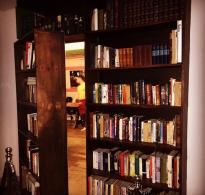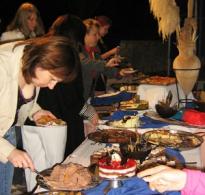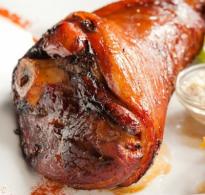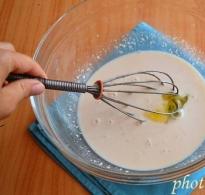Samarkand cakes. Uzbek flatbread
Uzbek flatbread- the national bread of the indigenous people of Uzbekistan, the divine taste of which will never get bored. Lush golden cakes, just taken out of tandoor(Eastern clay oven) beckons to eat them immediately from the heat - from the heat, without waiting until they cool down!
In the East, as you know, from small nails they instill respect for bread, here they don’t even cut it with a knife, but break it with their hands (according to legend, a knife can offend bread). Bread (non) is very holy for Uzbeks, so many rituals and beliefs are associated with cakes. Sending a loved one on a long journey, for example, to the army, he must definitely eat a small piece of cake, after which this piece of cake, dear to the house, is carefully stored until his return. They break the cake before the wedding ( rite of "breaking the cake"): as the parents of the bride and groom agreed on the joint future of their children, so as a sign of persuasion, they must break the cake, since there is nothing in the East more sacred than this wonderful bread! Here the most serious oaths are given on bread, and to break such an oath is the worst thing in the world!
What to say about what flatbread in Uzbekistan is practically a dish in itself? Hot golden cake with sweet green tea - breakfast, dessert and any other meal for a real Asian! Uzbek flatbread can be eaten with sweet melon and grapes (an unusually tasty combination), at lunch every day and at a festive dinner party.
Uzbek flatbread have a round shape with a patterned "middle", which, unlike the lush sides, does not rise during baking and is baked to a crispy crust.
 Cakes in each region of Uzbekistan have their own unique taste, shape and recipe. Samarkand, Bukhara, puff Kashkadarya flatbread, with meat, herbs - just your eyes run wide! By the way, there are 12 regions in Uzbekistan, of course, there are much more varieties of flat cakes.
Cakes in each region of Uzbekistan have their own unique taste, shape and recipe. Samarkand, Bukhara, puff Kashkadarya flatbread, with meat, herbs - just your eyes run wide! By the way, there are 12 regions in Uzbekistan, of course, there are much more varieties of flat cakes.
For example, Samarkand Patyrs- medium diameter, dense, heavy in weight, with ruddy smooth sides that shine like lacquer, and in the middle - a small patch, strewn with black sesame. An interesting fact is that Samarkand cakes with their peculiar taste are obtained only in Samarkand - as they say, Samarkand air is the main ingredient in the recipe. But Kokand Patyrs- on the contrary, they are wide, about 32 - 35 cm in diameter, flat and thin, with an ornament over the entire surface. These varieties of cakes have an incredible ability to remain soft for a long time and not lose their amazing taste. This property is convenient for tourists - they can buy a cake, bring it home in a few days, and it will be just as fresh and ruddy - a piece of the Uzbek sun, originally from hospitable Central Asia!
Tashkent is famous for its "airy" cakes, with crispy and incomparably tasty "bubbles". Cakes are sprinkled with black or white sesame seeds, and this gives them a special flavor.
But these, so to speak, are the visiting cards of cities, and in everyday life, dozens of different types of cakes are baked in every city of Uzbekistan. For example, homemade cakes simple ( obi non), bozor non, cakes with cracklings, cakes with meat, bran cakes, lush cakes, puff pastry, fried in oil with onions, etc.
 Cakes are made from rich, simple unleavened and yeast dough, sometimes with the addition of milk, sour cream, eggs, fat and herbal sourdough. Initially, yeast for cakes was not used, they took khamir truch or Khamir-my- a piece of the previous dough, and interfered with the fresh one according to the sourdough principle.
Cakes are made from rich, simple unleavened and yeast dough, sometimes with the addition of milk, sour cream, eggs, fat and herbal sourdough. Initially, yeast for cakes was not used, they took khamir truch or Khamir-my- a piece of the previous dough, and interfered with the fresh one according to the sourdough principle.
Despite the fact that the recipe and cooking technique may be the same, each baker makes cakes differently, and when you come to the market in the cake row, you are amazed at their diversity and beauty.
Classic Uzbek flatbread baked in tandoor. Therefore, even if you repeat the dough exactly, but bake it in the oven, it will not be the same at all. Although there are several types of Uzbek cakes, which are made in other ways. For example, puff pastry (katlama) - unleavened dough is rolled out, smeared with butter or sour cream, sprinkled with chopped onions on top, and all this is wrapped in a roll. Then they are cut crosswise in circles, they are formed into cakes and fried in a cauldron. Hearty and very tasty!
V tortilla bakery As a rule, only men work. It's very interesting to watch how to bake cakes. In order for the work to go quickly, and there was no fuss in a cramped room, the work in the bakery is conveyor. One rolls balls of dough, the second forms cakes from them and makes patterned punctures on them using special devices ( cakic, chekich- a pestle with sharp teeth), twisted sides (scallops), and the other deftly throws cakes into the oven (tandoor). The baker, like a tiger in the mouth, with lightning speed dives headlong into the red-hot muzzle of the furnace, sticks a cake on the wall of the tandoor and emerges for the next one.
Modern cakes are decorated with souvenir inscriptions for tourists and colored sesame seeds. tortilla frequently used and like a plate laying fruits, shish kebab on it.
To visit Uzbekistan and never taste a cake is like leaving a mine full of gold without noticing it!
Photos of Uzbek flatbread:













Author - begum. This is a quote from this post.
Samarkand cakes
Samarkand cakes are famous for their unique taste and properties of not stale for a long time. A real Samarkand flatbread should be usable for three years. To do this, it was enough to sprinkle it well with water and warm it up in a tandoor (a clay oven where cakes are baked). In modern conditions, the restoration of the cake can also be done using a microwave or a conventional oven.
It is known that Samarkand cakes were liked by the Emir of Bukhara, who once puzzled his courtiers: “I don’t understand why you are bringing me cakes from Samarkand, when they can be made with the same success here in Bukhara? Bring a baker from Samarkand and let him work here, at the court.”
No sooner said than done. They sent for the best cake maker to Samarkand, "The Emir ordered to appear!", Delivered to the Palace, "Now you will bake cakes here." There is nothing to do, you have to do it.But, no matter how hard the master tried, the cakes did not come out as tasty, as soft as those he made in Samarkand.
Probably, the matter is in the flour of Samarkand! ...
Probably, the matter is in the water of Samarkand! ..
Probably, the matter is in the tandoor from the land of Samarkand! ...
Everything, absolutely all the ingredients, were delivered to the master, but again and again, completely wrong cakes came out of the tandoor. What's the matter? “Perhaps the matter is in the air of Samarkand?” the master and the courtiers puzzled. But air cannot be transported ...
The masters were released, realizing that it was useless to try to reproduce the bread of the land of Samarkand. As before, they continued to deliver cakes. This continues to this day. Tradition.
If you go somewhere, take a Samarkand cake with you as a gift. The best, unique.
Samarkand cakes
Flour - 750 gr.
Milk - 375 ml.
Yeast - 1 tsp
Sugar - 1 tsp
Salt - 1 tsp
Butter - 125 gr.
Black sesame - 1 tbsp.
Yolk - 1 pc.
Milk - 1 tbsp.
Pour warm milk (375 ml.) into a bowl, add yeast, salt and sugar, mix. Add flour and melted butter. Knead the dough, knead the resulting dough for 10-15 minutes. And put it in a warm place, covering it with a towel or film for 40 minutes.
Then divide the dough into pieces (this amount of dough will make 2 large loaves, I got 4 medium ones) and roll them into koloboks. Then cover them with cling film and let them rest for 10 minutes.
Press the middle of the ball that has come up with your fist. And then hold the dough by the rim and rotate it in your hands - the dough stretches under its own weight, gradually turning into a cake. Put the cakes on a baking sheet with parchment (or just brush it with oil).
Cover the tortillas with a towel and let them rise and rest a bit, another 10 minutes. Meanwhile, preheat the oven to 220 degrees.
In a cup, mix the yolk with milk. Pierce the core of the bread with a nonpara (toothpicks or fork). Spread the egg mixture on the tortillas. Sprinkle sesame seeds on top and place them in the oven to bake until golden brown, 20 minutes.
Delicious and fragrant cakes with a crust on top, but soft inside, are ready.
Good appetite.
1 / 5
 2 / 5
2 / 5
 3 / 5
3 / 5

It is known that Samarkand cakes were liked by the Emir of Bukhara, who once puzzled his courtiers: “I don’t understand why you are bringing me cakes from Samarkand, when they can be made with the same success here in Bukhara? Bring a baker from Samarkand and let him work here, at the court.”
No sooner said than done. They sent for the best cake maker to Samarkand, "The Emir ordered to appear!", Delivered to the Palace, "Now you will bake cakes here." There is nothing to do, you have to do it.
But, no matter how hard the master tried, the cakes did not come out as tasty, as soft as those he made in Samarkand.
Probably, the matter is in the flour of Samarkand! ...
Probably, the matter is in the water of Samarkand! ..
Probably, the matter is in the tandoor from the land of Samarkand! ...
Everything, absolutely all the ingredients, were delivered to the master, but again and again, completely wrong cakes came out of the tandoor. What's the matter? “Perhaps the matter is in the air of Samarkand?” the master and the courtiers puzzled. But air cannot be transported ...
The masters were released, realizing that it was useless to try to reproduce the bread of the land of Samarkand. As before, they continued to deliver cakes. This continues to this day. Tradition.
If you go somewhere, take a Samarkand cake with you as a gift. The best, unique.
is one of the most popular traditional Uzbek dishes. This delicious bread is known not only in Uzbekistan, but also far beyond its borders. Samarkand cakes are known all over the world for their taste, patterns and ability not to go stale for a long time. Traditionally, it is customary to break off the cake with your hands, and not cut it with a knife.
The legend of Samarkand bread
There is an ancient legend about the Emir of Bukhara, who, having tasted Samarkand cakes, was so impressed by their taste and softness that he ordered the same cakes to be baked at his court. The courtiers sent for the best baker to Samarkand. But no matter how hard he tried, the cakes in Bukhara did not turn out exactly the same as in Samarkand. Then the baker explained to the angry Emir that he lacked Samarkand air for the natural taste of cakes.
What determines the taste of Samarkand bread?
Of course, the taste of cakes depends not so much on the air, but on water, flour and the oven in which they are made. A significant role is also played by the ability of the baker to accurately follow the traditional recipe, verified over the centuries, thereby conveying its original taste. Samarkand flatbread baked from ordinary dough on a special sourdough, which gives the cake a unique taste. Properly preparing dough for a tortilla is not an easy science and not everyone masters it. Experienced bakers are worth their weight in gold not only in Samarkand, but all over the world.
How is Samarkand bread baked in the tandoor?
Since ancient times Samarkand flatbread baked in a tandoor. A tandoor is a special type of semi-circular oven with an opening in the wall or in its upper part. Flat cakes molded from dough are glued to the walls of the tandoor and baked in this way until cooked. If the cake comes off the wall during baking, it is considered sacred. The temperature inside the tandoor is very high, and cakes are baked in it in a matter of minutes. When the cakes are ready, the baker takes them out of the tandoor with a special spatula or mitten.
A little about the varieties of cakes
The most common Uzbek flatbread is Samarkand, but there are several other types of flatbread.
obi-non flatbread;
flatbread screen-non;
cake gala-osiegi-non;
kokand patyr;
Fergana guide;
Samarkand gallasie;
jizzali-non cake.
Various cakes are made with a slightly modified recipe and with the addition of new ingredients. Incredibly delicious puff pastry Katlama cakes, jizzali-non cakes with mouth-watering cracklings; zogora-non cakes made from cornmeal, kuk-patyr cakes with herbs and herbs, and many other types.
Customs associated with Samarkand bread
There has long been a custom according to which, if a person leaves the house, he should bite off and eat a piece of cake. herself cake should be kept at home until his return. When the traveler returns, he must eat it up.
Bread is highly respected in Uzbekistan. Long time ago there was an old national tradition to wear a basket with cakes on the head. This meant special respect and reverence for bread.
Even during the marriage ceremony, they do not forget about the Samarkand cake. It is customary for Eastern peoples to perform the traditional ritual of breaking bread - most often traditional wedding bread is cake.
Data-yashareType="button" data-yashareQuickServices="yaru,vkontakte,facebook,twitter,odnoklassniki,moimir,lj,friendfeed,moikrug,gplus,surfingbird">






